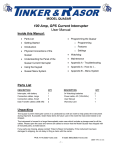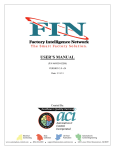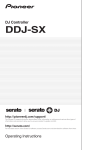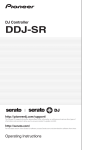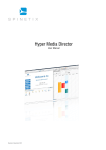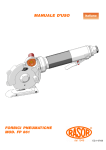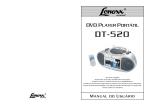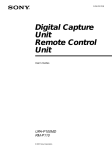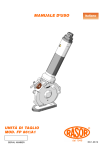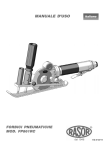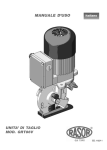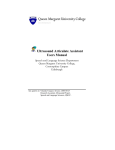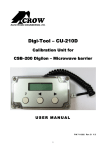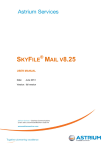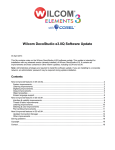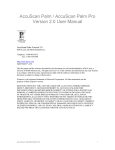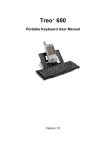Download DL-1 Old Instructions
Transcript
MODEL DL-1 v. 2.0 User Manual Unpacking Checklist The Model DL-1 Data Logger Kit includes the following: Model DL-1 Logging Unit 6A Half Cell Reference Electrode TRAC Configuration & Analysis Software CD Carrying Case 9-pin Communications Cable 9-Volt Battery 4-Channel Sampling Interface Cable Warranty Registration Card Adapter, Serial Cable to USB port The information contained in this document is subject to change without notice and does not represent a commitment on the part of Tinker & Rasor. All listed trademarks and trade names are the property of their respective owners. Any and all reproduction or transmission of any part of this manual, in any form or by any means and for any purpose other than the personal use by the purchaser is strictly forbidden without the express written authorization of Tinker & Rasor. This manual contains User Information for the Tinker & Rasor Model DL-1 and the Tinker & Rasor TRAC software package, version 2. For software updates, please visit our website: http://www.tinker-rasor.com/software © 2003 Tinker and Rasor, Inc. All rights reserved. 011-228 Tel: (909) 890-0700 Fax: (909) 890-0736 P. O. BOX 6890 SAN BERNARDINO, CA 92412 Web: www.tinker-rasor.com E-mail: [email protected] i Sponsoring members of NACE International, NACE Foundation 1.0 Computer Software Setup ...........................................................................1 1.1 Computer System Requirements ................................................................................... 1 1.2 Software Installation ..................................................................................................... 1 1.3 Communication Setup ................................................................................................... 1 2.0 Quick Start ...................................................................................................2 2.1 Quickstart Introduction ................................................................................................. 2 2.2 Quickstart Operation Diagram ...................................................................................... 2 3.0 Feature Summary ........................................................................................6 3.1 Operation Overview ...................................................................................................... 6 3.2 Creating A Configuration Document ............................................................................ 9 3.3 3.4 3.2.1. Setting Up the Configuration .............................................................................. 10 3.2.2. Recommended Procedure ................................................................................... 10 3.2.3. Channel Selections ............................................................................................. 10 3.2.4. Sequence Parameters .......................................................................................... 11 3.2.5. Status Section, Configuration Window .............................................................. 12 3.2.6. Notes & Advanced Options ................................................................................ 12 Communication ............................................................................................................. 12 3.3.1. Send Configuration ............................................................................................. 13 3.3.2. Receive Data....................................................................................................... 13 Hardware Setup and Use Overview .............................................................................. 13 3.4.1. Connecting the Sampling Interface Cable .......................................................... 13 3.4.2. Data Logger Panel .............................................................................................. 14 3.4.3. Power Supply ..................................................................................................... 14 3.4.4. Start/Stop ............................................................................................................ 14 3.5 View Data - Spreadsheet ............................................................................................... 16 3.6 View Data - Graph ........................................................................................................ 16 Tel: (909) 890-0700 Fax: (909) 890-0736 P. O. BOX 6890 SAN BERNARDINO, CA 92412 Web: www.tinker-rasor.com E-mail: [email protected] ii Sponsoring members of NACE International, NACE Foundation 4.0 Feature Details .............................................................................................17 4.1 Status Window .............................................................................................................. 17 4.2 Configuration Options ................................................................................................... 18 4.3 Scaling Inputs & Data ................................................................................................... 19 4.3.1. Channel Details .................................................................................................. 19 4.3.2. Sensors & Scaling Methods ................................................................................ 20 4.4 Triggering, Event-based Recording .............................................................................. 22 4.5 Spreadsheet View Features ........................................................................................... 23 4.6 4.5.1. Scaling Spreadsheet Data ................................................................................... 23 4.5.2. Spreadsheet Statistics ......................................................................................... 24 4.5.3. Printing Spreadsheet Data .................................................................................. 24 4.5.4. Exporting Spreadsheet Data ............................................................................... 24 Graph View Features ..................................................................................................... 24 4.6.1. Scaling Graph Data............................................................................................. 25 4.6.2. Graph Statistics................................................................................................... 25 4.6.3. Printing Graphs ................................................................................................... 26 4.6.4. Exporting Graphs ............................................................................................... 26 4.6.5. Formatting Graphs .............................................................................................. 26 5.0 DL-1 Data Logger Unit Operation .............................................................27 6.0 Appendix A: Technical Information ..........................................................29 7.0 Appendix B: Recording and Data Transfer Connections ........................31 8.0 Appendix C: Example of Standard Connection ........................................32 9.0 Appendix D: Technical Support Resources ...............................................33 10.0 Index ..............................................................................................................34 Tel: (909) 890-0700 Fax: (909) 890-0736 P. O. BOX 6890 SAN BERNARDINO, CA 92412 Web: www.tinker-rasor.com E-mail: [email protected] iii Sponsoring members of NACE International, NACE Foundation 1.0 Computer Software Setup 1.1 Computer System Requirement IBM PC or Compatible, 386 speed processor or better CD-ROM, DVD-ROM, CD-R or MultiRead CD Drive 8 MB RAM minimum, 16 MB recommended Windows 95, 98 or newer or Windows NT 4.0 or newer 8 MB available hard disk space **NOTE: If you do not have a CD drive on the target computer system, a self installing file is available for downloading from the world wide web. Contact your distributor for the current web site address. The DL-1 system is capable of collecting large amounts of data and presenting the information graphically. Because of this, we recommend that you install the Tinker & Rasor TRAC Configuration and Analysis software on a PC with a fast microprocessor (200MHz or faster) and at least 16MB of memory (RAM). For information about using the DL-1 with handheld computers, please see separate PDA User Manual or contact Tinker & Rasor. Telephone: 626-287-5259 1.2 Software Installation Insert the installation disk in the appropriate disk drive. 1. 2. 3. 4. 1.3 The CD installation will begin automatically. If the installation program does not open, select Run from the Start menu and type in or Browse to D:\Autorun\autorun.exe, where D: is your CD drive. Double click the TRAC Setup icon in the installation window. Follow the on-screen instructions. To begin, select the Tinker & Rasor TRAC program from the Start | Programs menu, or double-click on the trac.exe file from Windows Explorer in the directory where you installed the program (default directory – C:\Program Files\Tinker and Rasor\trac.exe) Communication Setup From the Communication pull-down menu, select Setup to setup or change the communications port selection for the PC. At left is the dialog box that appears. Select the correct COM port or use Auto Find. Auto Find will find the correct port if the logging unit is in the “Off” mode, and is connected to an available COM port on your computer. This will only need to be done once, unless the PC’s hardware is changed or a different PC is used. Tel: (909) 890-0700 Fax: (909) 890-0736 P. O. BOX 6890 SAN BERNARDINO, CA 92412 Web: www.tinker-rasor.com E-mail: [email protected] 1 Sponsoring members of NACE International, NACE Foundation Most commonly, COM1 or COM2 is used. For notebook computers, almost always COM1 is used, but on some older computer models COM1 is used by the Mouse, so you would then use COM2. Rarely is COM3 or COM4 used. A confirmation window appears when Auto Find locates the data logger. Click OK. Click OK again to close the Communications Port window. A 9-pin communications cable (null modem cable, included. Please see Appendix B: Recording and Data Transfer Connections) is used to connect the DL-1 to the host computer. 2.0 Quick Start 2.1 Quick Start Introduction The Model DL-1 logging unit can sample up to 4 analog channels simultaneously, as fast as 512 times per second or as slow as one time every 99 minutes, with the capacity to store over 540,000 readings. The Tinker & Rasor TRAC (True Recording and Capture) Configuration and Analysis software was designed to be intuitive, so that you can put this capability to work, right out of the box. The “Quickstart Operation Diagram” in the next section (Section 2.2) shows you how to do this. By understanding the basic framework of the DL-1 system, you will find that each time you put the system to work, your experience will not be one of constant “relearning” but one of increasing convenience. Tips are listed in this introduction and throughout the User’s Guide to help you save even more setup time in future applications. **Tip: You may use the system for many different applications, or you may use it for the same application every time. In either case, it will be valuable for you to be able to reuse any work you have done in the past. The TRAC software gives you the capability to do this by saving configuration files and sensor profiles. Choose meaningful names for configuration files and sensor profiles so that you may find them and use them again in the future, either for reference or for additional data acquisition tasks. **Tip: Notes can be typed directly into the configuration window for reference. This is an extremely valuable feature, and the notes are saved and stored to disk along with ALL configuration settings in data and graph files. In the same way, all raw data that is retrieved from the logging unit is stored in a graph file. The TRAC software allows you to recreate a configuration or a complete raw data file, along with scale settings, from a graph file. This capability makes it easy to organize data and assures that you can always duplicate a setup, effortlessly. 2.2 Quick Start Diagram Connect the DL-1 Data Logger to your PC or Handheld computer. Tel: (909) 890-0700 Fax: (909) 890-0736 P. O. BOX 6890 SAN BERNARDINO, CA 92412 Web: www.tinker-rasor.com E-mail: [email protected] 2 Sponsoring members of NACE International, NACE Foundation Open the TRAC software program Open a New configuration window. Set the configuration and save. Send the configuration. The DL-1 is now configured. Tel: (909) 890-0700 Fax: (909) 890-0736 P. O. BOX 6890 SAN BERNARDINO, CA 92412 Web: www.tinker-rasor.com E-mail: [email protected] 3 Sponsoring members of NACE International, NACE Foundation Connect the DL-1 in the field. Connect the Data Logger in the field using the included cable with four pairs of clamps. The clamps make it easy to connect to test stations, like the connection at left between the DL-1 Data Logger and the Tinker & Rasor CP Test Station Model T-3. The DL-1's slim body allows it to slide through the test station head and hide in the riser pipe. A convenient and safe location to deploy the DL-1, without having to remove the test station! You can see the cutout of the test station terminal marked with an X at left. (This is true for the Tinker & Rasor Model T-3 CP Test Station. May not apply to other manufacturers test stations.) Press the Start/Stop button on the DL-1. The DL-1 is now recording. The DL-1 has only one button on it: Start/Stop. All configurations are done through the computer. This makes the DL-1 the easiest data logger to deploy. Press Start/Stop and leave. Come back and press Start/Stop and you are done. (You do not have to press the button at all if you have configured a start and stop date/time.) Retrieve the DL-1 from the field and re-connect it to your PC or Handheld computer. Connect the DL-1 to your PC using the included cable. The 3-pin (round) end of the cable connects to the DL-1, the 9pin (serial connector) end connects to the computer. Tel: (909) 890-0700 Fax: (909) 890-0736 P. O. BOX 6890 SAN BERNARDINO, CA 92412 Web: www.tinker-rasor.com E-mail: [email protected] 4 Sponsoring members of NACE International, NACE Foundation Open the TRAC software program and the click Receive Data button. Make sure that the Model DL-1 Data Logger is turned off when connected to the PC or handheld computer. (No lights are visible on the face of the Data Logger) **NOTE: The LED on the face of the DL-1 will blink when the unit is recording. The speed at which the LED will blink is configurable to allow for maximum battery life. To determine if the unit is turned off, the LED’s should be observed for at least 2 seconds. View Spreadsheet. When viewing data in the Spreadsheet window, the user can see the record number, interval between reads, value columns and date and time of the read. It is also possible to hide columns to be able to focus on just the data you are interested in. Tel: (909) 890-0700 Fax: (909) 890-0736 P. O. BOX 6890 SAN BERNARDINO, CA 92412 Web: www.tinker-rasor.com E-mail: [email protected] 5 Sponsoring members of NACE International, NACE Foundation View Graph. When viewing the data as a graph, it is possible to set statistical lines of Minimum, Maximum, Mean, Standard Deviation and Regression. Also, zooming in and out of the graph allows you to view all of the data at once, or just the sequences or individual reads you wish to view. Save, print, export. Spreadsheet data can be exported as comma separated text for importing into other spreadsheet programs, or as xml based for exporting onto the web. It is important to note that saving (exporting) the data into any format other than the ".dld" format in the TRAC software program will allow you to change the raw data. Changing is not possible within the TRAC software program. Graph data can also be exported as an image file. 3.0 Feature Summary Data Acquisition Stand-alone operation – uses internal memory to store data Interval Recording Trigger-based (Event) Recording and Repetitive Triggering Status Indication: Sampling, Trigger-Mode, Memory Full, Low Battery Low-Power, Battery Operation 10-year battery backup and software interlock to protect data Software Framework The TRAC Configuration and Analysis software framework is compatible with all current level Tinker & Rasor DL-1 data acquisition systems. One-button operations to setup the logger, receive data and generate graphs. Tel: (909) 890-0700 Fax: (909) 890-0736 P. O. BOX 6890 SAN BERNARDINO, CA 92412 Web: www.tinker-rasor.com E-mail: [email protected] 6 Sponsoring members of NACE International, NACE Foundation Configurations, data and graphs are treated as documents, much like a word processing program treats documents. All information is carried forward to the next level ‘document’, which means that you don’t have to save configurations, data and graphs together as a set – a configuration can be created from an existing data file or graph file; a data file can be created from a graph file. Once a graph is created from data collected by the logging unit, the configuration and data files can be discarded, if desired, for the purpose of storing and organizing data files more efficiently. The ‘configuration’ button on the status window allows you to create a configuration ‘document’ from the logging unit that is currently connected to the PC. Data View & Analysis View all data or view only the data acquired from individual recording ‘sequences’. Export/Copy data in table or graphical format to file or directly to any other program. Print data in table or graphical format. Print or copy configuration and status window information. This is useful for documenting collected information. Statistics may be viewed in table and graph views. **NOTE: The DL-1 system is Year 2000 (Y2K) compliant. 3.1 OPERATION OVERVIEW This overview covers the five (5) basic steps involved in collecting and reviewing data. Section 4.0 Feature Details, covers more advanced features, in addition to instructions for reviewing, formatting and exporting in the spreadsheet and graph windows. Step 1: Create a Configuration Document 3.2 Step 2: Communication - Send a configuration 3.3 Step 3: Recording Data - Hardware 3.4 Step 4: Spreadsheet Data View - Receive data 3.5 Step 5: Graph Data View - Generate a graph 3.6 Status Window The status window (shown on next page) displays the status and specification of the Tinker and Rasor DL-1. Tel: (909) 890-0700 Fax: (909) 890-0736 P. O. BOX 6890 SAN BERNARDINO, CA 92412 Web: www.tinker-rasor.com E-mail: [email protected] 7 Sponsoring members of NACE International, NACE Foundation Inputs Analog – Four independent channels simultaneously recording AC or DC voltages. Range selectable: 300 VAC RMS Range or +/- 5 VDC to +/- 100V DC (bipolar). Range selectable: 1A, 10A and 100 Amps. Input resolution +/- .01% of selected range. Channel Configurations: Channel 1 & 2 – Bipolar DC analog input with automatic AC rejection for data collection and recording traditionally preformed with a Digital Volt Meter. +/- 5V DC range. Software is configurable for DC current readings with the appropriate shunt. (see SHUNT Details in table below.) Channel 3 – 300V AC RMS range. Channel 4 – Bipolar DC analog input with TrueView. Software configurable for AC current readings with optional amp clamp. SOFTWARE CONFIGURABLE SHUNTS CHANNELS AVAILABLE .001 Ohm 1&2 .01 Ohm 1&2 .1 Ohm 1&2 1.0 Ohm 1&2 AC Amp Clamp, 0 – 100 Amps 4 Data Storage Data Storage – 500,000 samples. Recording Duration: 0.002 seconds to years. Sampling Frequency: Fast as 500 Hz, Slow as 99 min. (all channels). Data Memory Battery Life: 10 years. Operating Power Supply: 9V battery or adapter. Recorded data retained in memory in the event of 9V-battery failure. Battery Life: Up to 2 months 9V alkaline, Up to 4 months, lithium. Temperature Operating: -10 to 60 degrees C. Temperature Storage: -20 to 70 degrees C. Status – Led Indication of Logger off/on, Data collection start, Logging stopped/complete, Low battery and Memory full. Communication RS-232 Interface Baud Rate – 9600 BPS to 115.2k BPS Tel: (909) 890-0700 Fax: (909) 890-0736 P. O. BOX 6890 SAN BERNARDINO, CA 92412 Web: www.tinker-rasor.com E-mail: [email protected] 8 Sponsoring members of NACE International, NACE Foundation Software Configuration and Data Retrieval from Microsoft® Windows® 95, Windows® 98 or Windows NT® 4.0 or later, Palm™ handhelds or Palm Powered™ handhelds, such as Handspring™ Visor™, running Palm OS® 3.4 or later. View Graph – Displays graphs for analysis or presentation. With Copy, Paste, Print and Export functions. Spreadsheet for display of channel voltage, current and/or event data. Each logged event has a date and time stamp. Data collection can be started and stopped by a programmed time/date or manually. The Status window shows the configuration of a logging unit that is connected to the PC – it is your “window” to the data acquisition hardware. (Status window shown at top of previous page) If a logging unit is connected when the TRAC Configuration and Analysis program is started, its status will be displayed automatically. Other messages relating to the most recent communication with the logging unit will also be displayed here. The display can be updated at any time by selecting the refresh button on the main program toolbar. For more information on the Status Window, please go to Section 4.1: Status Window. 3.2 Create a Configuration Document Before recording information with the logging unit, you must first configure it. This is done by creating a configuration ‘document’ and then sending it to the logging unit. Configuration documents can be created once and saved to disk for reuse in future data collection tasks. The first step in creating a configuration is to open a New Configuration template by selecting File New Configuration from the main menu. Be sure to select the configuration template that matches the target logging unit model. The model number of a logging unit that is connected to the PC’s communication port can be found at the top of the Status window. File New Configuration Previously saved (to disk) configurations are opened by selecting File Open. **NOTE: A configuration document may also be created from a connected logging unit by clicking the configuration button on the main program toolbar. Configurations can be generated directly from data (.dld) and graph (.dlg) files by clicking on the configuration icon on the spreadsheet and graph window toolbars. Tel: (909) 890-0700 Fax: (909) 890-0736 P. O. BOX 6890 SAN BERNARDINO, CA 92412 Web: www.tinker-rasor.com E-mail: [email protected] 9 Sponsoring members of NACE International, NACE Foundation 3.2.1. Setting Up the Configuration Recording parameters (sample interval, run time, channel selections, etc.) are established in the configuration. A new configuration is already initialized with everything necessary to begin recording – it can be sent to the logging unit and used, as is. However, you will want to customize the configuration for each task. The configuration window is a “smart form” that automatically calculates sequence parameters and displays: 1) the fastest Sample Frequency possible, and 2) the Total Run Time that is based on using 100% of the data storage memory available in the target logging unit. These calculations are updated when you make changes. For example, if you add 3 channels to the default configuration (1 to 4), the Total # of Samples and Total Run Time will be reduced by a factor of 4. However, you can “lock in” a Total Run Time by clicking the Lock checkbox next to the Total Run Time field. Similarly, you can “lock in” a Sample Interval/Frequency by clicking the Lock checkbox next to that field. 3.2.2. Recommended Procedure To appreciate the benefits of the “smart form” feature, specify recording parameters in the following order: Select each channel to be sampled and enter meaningful channel names. Set the “Total Run Time” if the test is to be terminated after a specified period of time (though a logging sequence may be interrupted at any time by pressing the “Start/Stop” button on the panel). Or Set the “Total # of Samples” if the test is to be terminated automatically after a specified number of samples have been acquired. Set the “Sample Interval/Frequency” – the time base may be changed by selecting the time base button to the right of the “Sample Interval/Frequency” entry field. 3.2.3. Channel Selections Record The Tinker & Rasor Model DL-1 has 4 analog channels available. Click the checkbox to select the channels that will be logged during the recording. Use the scroll bar on the right to bring other channels into view. Tel: (909) 890-0700 Fax: (909) 890-0736 P. O. BOX 6890 SAN BERNARDINO, CA 92412 Web: www.tinker-rasor.com E-mail: [email protected] 10 Sponsoring members of NACE International, NACE Foundation Label After selecting a channel, the cursor will move to the channel name field. You may enter a meaningful name for each channel, up to 15 characters. Details Click on the detail button to access more advanced options for the input channels, such as scaling and triggering parameters. For more information regarding scaling and triggering, please see Section 4.3.1: Channel Details – Scaling & Triggering. 3.2.4. Sequence Parameters Sample Interval (Frequency) The default sample rate for a New Configuration is 500 Hz (500 samples per second). The sample rate is autocalculated following entry of other configuration parameters to display the shortest sample interval available. To set the Sample Interval for a logging sequence, first set the time base by clicking on the Time-Base Button. Next, type in the desired Sample Interval or Frequency. The Sample Interval field will automatically “lock” when you modify it, disabling automatic calculation of the Sample Interval/Frequency. **NOTE: You may wish to select recording channels and define labels before specifying sequence parameters. This will enable you to see the automatic calculations for total run time and total number of samples. Total Run Time The Total Run Time parameter allows you to set the duration of a single logging sequence. To automatically terminate logging after a specified period of time, enter the desired number of days, hours, minutes and seconds in the respective fields Auto-calculation displays the Total Run Time that will result when recording from the selected input channels, at the specified Sample Interval and using all 500,000 data storage locations. When configuration parameters are changed this field is recalculated, unless it is locked. Total Run Time will automatically “lock” if you enter a value in this field, or by clicking in the Lock checkbox. The field may be “unlocked” by deselecting the Lock check box. If the option button to the left of the “lock” check box is not selected, the Total Run Time parameter is not enabled. In this case, the Total # of Samples determines the Total Run Time of the sequence, in combination with the Sample Interval. Total Number of Samples The Total # of Samples parameter allows you to define a logging sequence by the number of samples to be recorded. A sample is defined as a one record of all selected channels. To terminate logging after a specified number of samples have been logged, enter the desired number of samples in this entry field. Manual entry into this field “locks” the Total # of Samples parameter, disabling the auto-calculation feature. The field may be “unlocked” by deselecting the Lock check box. Tel: (909) 890-0700 Fax: (909) 890-0736 P. O. BOX 6890 SAN BERNARDINO, CA 92412 Web: www.tinker-rasor.com E-mail: [email protected] 11 Sponsoring members of NACE International, NACE Foundation If the option button to the left of the “lock” check box is not selected, the Total # of Samples parameter is not enabled. In this case, the Total Run Time determines the number of samples in the configured sequence, in combination with the Sample Interval. 3.2.5. Status Section, Configuration Window This section indicates the total number of input channels selected for recording. It also displays the percentage of memory required for the configured logging sequence, and the number of sequences of this particular configuration that can be recorded with the available data storage memory. For more information on memory use, please go to the Section 4.2: Configuration Options – Memory Use. 3.2.6. Notes & Advanced Options Notes Select the Notes button to display the “Notes” section of the configuration window. The notes section is convenient for documenting test setup, special equipment, general explanation of intended uses for the configuration and test results information to be kept on file for later use. These notes are saved with the configuration so that whenever the configuration is reloaded from the disk, the test notes will also be available. To view, click the Notes button. **Tip: This is an extremely valuable feature, when utilized: notes, along with ALL configuration settings are stored in data and graph files that are saved to disk. In the same way, all raw data that is retrieved from the logging unit is stored in a graph file when saved to disk. The TRAC software allows you to recreate a configuration or a complete raw data file, along with scale settings, from a graph file. This capability makes it easy to organize data and assures that you can always duplicate a setup, effortlessly. Advanced (Please see Section 4.2: Configuration Options – Advanced Configuration Options) 3.3 COMMUNICATION The DL-1 Logging unit must be in “Off” mode in order to communicate with the TRAC Configuration and Analysis software through a PC serial communications port. Communication codes sent by the PC will “wake up” the logging unit each time communication is initiated. A transfer of information takes place between the PC and logging unit for the following functions: Configuration of logging sequence parameters Transfer of data to the PC Transfer of logging unit status to the PC Setting the logging unit’s internal clock Personalization of the logging unit with a meaningful name The first of these functions, configuration and data transfer, are initiated by clicking icons on the main program toolbar, or by selecting the appropriate sub-menu item under Communications on the menu bar, which are described below. The remaining communications functions may also be accessed from the main menu and toolbar, and are described in Section 4.1: Status Window. Tel: (909) 890-0700 Fax: (909) 890-0736 P. O. BOX 6890 SAN BERNARDINO, CA 92412 Web: www.tinker-rasor.com E-mail: [email protected] 12 Sponsoring members of NACE International, NACE Foundation 3.3.1. Send Configuration **NOTE: If data has been logged but not yet received into a data window, this should be done before re-configuring the logging unit (see Section 3.3.2: Receive Data). To send a configuration to the logging unit, be sure the unit is not recording (stopped) and is connected to a serial (COM) port on the PC with the supplied communications cable. Also make sure that the Configuration window is the active “window”. From the Communications menu, select Send Configuration. It takes approximately 10 seconds to send the configuration and to program the logging unit (use the Communications Setup menu option to change ports if necessary – see Section 1.3: Communication Setup). Select “OK” at the warning prompt to proceed. The warning prompt helps avoid accidental loss of data, as this process overwrites the previous configuration and access to recorded data is lost. If you have any problems, check to make sure that the Configuration window type (DL-1) matches the logging unit. The logging unit model number appears at the top of the Status window. If you still have problems, recheck the cable connection and verify that your COM port is set up properly. 3.3.2. Receive Data To receive the recorded data, make sure the logging unit is connected to a serial port on the PC with the supplied communications cable or to a PDA using Palm OS with optional cable. From the Communications menu, select Receive Data. While data is being transferred, the progress level is displayed on a meter. If errors occur while attempting to receive data, make sure that the correct COM port is selected (see Section 1.3: Communication Setup). Also, make sure the cable is securely connected at both ends. Once the data is received, a variable-size spreadsheet is created, based on channels configured and the number of samples recorded. This is the spreadsheet window, which is specially formatted with the channel names that were specified in the configuration. 3.4 Recording Data – Hardware This section gives only a brief overview of the DL-1 logging unit and it’s use for recording data. For more detailed information, please see Section 5.0: The DL-1 Data Logging Unit Operation, or Appendix A: Technical Information. 3.4.1. Connecting the Sampling Interface Cable Connect the 4-channel cable (included in the shipping package) to the connector on the end of the datalogger. The labeled clips will connect to the equipment being tested. All leads are color-coded and labeled. Tel: (909) 890-0700 Fax: (909) 890-0736 P. O. BOX 6890 SAN BERNARDINO, CA 92412 Web: www.tinker-rasor.com E-mail: [email protected] 13 Sponsoring members of NACE International, NACE Foundation 3.4.2. Datalogger Panel The panel of the logging unit includes a color legend for the two LED displays. This legend describes the operating mode associated with each color displayed by each LED and the corresponding text in the same color. A flashing display is differentiated from a solid color. *Trigger Mode: The green and orange display flash alternately to indicate the logging unit is waiting for the trigger condition to occur. 3.4.3. Power Supply The DL-1 logging unit is powered by one (1) 9V battery, and an internal Lithium battery for data backup. The 9V battery is replaceable. Remove end cap marked, BATTERY ACCESS, by removing three screws. Insert battery, observing polarity. The sticker on the inside of the battery compartment (shown above) shows where the positive terminal on the battery should be inserted. The battery terminals face INTO the unit when the battery is inserted. Do not over-tighten screws when replacing BATTERY ACCESS panel. For information on battery life, please see Appendix A: Technical Information – Battery Life vs. Configuration. 3.4.4. Start/Stop Press the Start/Stop button to begin logging. A configured logging sequence will be terminated automatically upon completion, but may be stopped and restarted manually by pressing the Start/Stop button. The logging unit must be in the “off” mode for configuration for communications. 3.5 Spreadsheet Data View This spreadsheet has the same look and feel as popular spreadsheet programs and data is compatible for exporting to most Windows platform spreadsheet or analysis program. For information on scaling, statistics, printing, exporting, and saving spreadsheet files, please see Section 4.5: Spreadsheet View Features. All options are available on the right mouse menu and also on the main menu bar under Options Data. Position the mouse over the spreadsheet, click the right mouse button and the menu will appear. All functions necessary for viewing or exporting are available. To select a range of cells, select a corner and Tel: (909) 890-0700 Fax: (909) 890-0736 P. O. BOX 6890 SAN BERNARDINO, CA 92412 Web: www.tinker-rasor.com E-mail: [email protected] 14 Sponsoring members of NACE International, NACE Foundation drag the mouse to the opposite corner. A column or row of cells may be selected by clicking on the column/row header cell. Click the right mouse button to bring up a menu of choices. Top and Bottom Rows Click these buttons to move to the top or bottom rows of the spreadsheet. “Previous” Sequence and “Next” Sequence Click these buttons to move the cell cursor to the first row of the next or previous data sequence. These buttons will have no effect if you are viewing data file that was recorded in a single sequence. Column otuA -Size Use this button to automatically size the selected column(s) to the labels and data in view at a given time. This is normally not necessary but should be used when viewing the cells in the statistics summary – since the information in these cells is so much wider than is typically in data and label cells, it is sometimes partially hidden to optimize the spreadsheet view. Create Graph A new graph window is generated each time this button is selected. The new graph is a stand-alone “database” that includes all raw data and configuration information. Refer to the Section 4.6 - Graph View Features for more information about graphs generated from the Spreadsheet Data View. Create Configuration (Spreadsheet) Clicking this button will cause a configuration “document” to be generated from the Spreadsheet Data View “database”. The spreadsheet has all of the necessary information to construct a duplicate of the original configuration that was used to record the data. Data Organization Data is organized as one row per sample record. Records that represent the time at which recording sequences were started are color-coded green. The last sample record in a sequence is red. All other records are displayed with black text. Each sample record consists of three specific column types: Interval, Sample Data and Time Stamps. Interval This column displays the actual time of each sample, starting at 0.0 for each recording sequence and increased by the sample interval value. This column is provided for convenience in creating X-Y charts, as it can be used for “Xrange” data. Sample Data These columns display sample data read from the specified input channels – one column per selected channel. The user-defined channel label is the column name and the ‘engineering units’ are displayed in the first row. Analog data is displayed as scaled values; by default, 0 to 5 volts. Time Stamps The data and time for each data sample are displayed in this column. Data recorded from multiple logging sequences is displayed sequentially. That is, the first data record in a logging sequence is displayed immediately following the Tel: (909) 890-0700 Fax: (909) 890-0736 P. O. BOX 6890 SAN BERNARDINO, CA 92412 Web: www.tinker-rasor.com E-mail: [email protected] 15 Sponsoring members of NACE International, NACE Foundation last record of the previous sequence. The start of a new sequence is easily distinguished by the green-colored text, in addition to the 0.0 value in the Interval column. 3.6 Graph Data View **NOTE: Various formatting options are available on the right mouse menu. Access this menu by placing the mouse over the graph window and clicking the right mouse button. “All: Sequences Method” Click this toggle button ‘on’ to view all recorded sequences as they were on continuous of paper. Each sequence starts right after one another, end-to-end. The x-axis values will reset and count up for each sequence. When viewing the graph this way, the next and previous sequence buttons have no effect. The Graph Start button moves to the beginning of the 1st sequence. The Graph End button moves to the end of the last sequence. “Individual” Sequence Method Click this toggle button ‘on’ to view each sequence individually in the graph window. The scroll bar at the bottom will scroll from the beginning of the current sequence to the end of the current sequence. If you want to view other sequences, click the next and previous buttons. This current sequence is displayed on the tool bar. Graph “Beginning” and “End” Click these buttons to move the graph view to the beginning of the 1st sequence, or the end of the last sequence regardless of the current graph method. If you are viewing multiple sequences and want to move to the beginning of a particular sequence, use the scroll bar. Graph “Next” and “Previous” Sequence Click these buttons to move between sequences. Zoom “In” and “Out” Click this button to zoom in on the data by a factor of 2. The center of the graph window is the zoom point. Open Data View (Spreadsheet) Click this button to show the spreadsheet data view. Tel: (909) 890-0700 Fax: (909) 890-0736 P. O. BOX 6890 SAN BERNARDINO, CA 92412 Web: www.tinker-rasor.com E-mail: [email protected] 16 Sponsoring members of NACE International, NACE Foundation Create Configuration (Graph) Use this option to open the configuration form with the parameters used to generate this data. This allows you to quickly configure a logging unit from a previous test file because all options are duplicated from the original configuration. 4.0 Feature Details This section will discuss in detail some of the advanced features of the TRAC Configuration and Analysis software program. 4.1 Status Window For general information about the Status Window and its function, please refer to the Section 3.1: Operation Overview – Status Window. The status of the device currently connected to the communication port is displayed in the status window. (See graphic in section 3.1, Status Window) A tool bar is displayed at the top of the main program window. Certain tools on the toolbar are used to communicate with devices connected to the communication port. Clicking the right mouse button while the cursor is over the status window will also bring up the menu of available communications functions. Name The logging unit may be personalized for identification. This is especially useful when more than one DL-1 is in use for the same or similar applications. The name can have up to 15 characters and may contain any keyboard character. The current name is listed at the top. It is also initially placed in the edit field. To change the name, just enter a new name (up to 15 characters) and then press the OK button. Clock The logging unit contains a real-time clock. Use this option to change the time and date. The PC’s current date and time are the default values placed in the edit fields. To synchronize the DL-1 logging unit’s internal clock to the PC, just select “OK”. Any other valid setting may be entered, as well. The DL-1 system is Year 2000 (Y2K) compliant. Tel: (909) 890-0700 Fax: (909) 890-0736 P. O. BOX 6890 SAN BERNARDINO, CA 92412 Web: www.tinker-rasor.com E-mail: [email protected] 17 Sponsoring members of NACE International, NACE Foundation **NOTE: The time is in 12-hour format (AM or PM must be specified) and the date is month/day/year (2-digit year). This software recognizes the years “00” and up to be the years 2000 and up, so there is no concern for Y2K problems. Refresh When the program first starts up, it determines if there is a logging unit connected, and if so, it will display the status. At anytime you can press the Refresh button to get the most-up-to-date status of whichever device is connected. Contents of the Status Window The Status window is a direct link to the DL-1 logging unit. Information displayed here resides in memory within the logging unit, including; date and time of configuration, number and name of input channels selected, configuration parameters and available memory. If there is more information than space provided, scroll bars will appear to permit full viewing. The status window is updated each time communication is established between the PC and the logging unit. 4.2 Configuration Options Memory Use Each analog channel requires 1 memory storage location (500,000 storage locations are available for sampled data). Selecting all 4 analog channels would use 4 storage locations each time the inputs are sampled. Advanced Configuration Options Advance Configuration options are accessed from the Advanced button located in the Status section of the Configuration window. Logging Indication Flash Interval The Logging Indication Flash Interval is the rate at which the Light Emitting Diode (LED) indicator flashes (green) while the logging unit is in the Logging mode. **NOTE: Advanced options control the general operation of the logging unit, affecting battery life and behavior following Tel: (909) 890-0700 Fax: (909) 890-0736 P. O. BOX 6890 SAN BERNARDINO, CA 92412 Web: www.tinker-rasor.com E-mail: [email protected] 18 Sponsoring members of NACE International, NACE Foundation power interruptions. Theory of Operation Typically, the LED flashes each time a sample is logged; however, if the sample interval is very fast, .05 seconds or less, the LED will stay on constantly while the logging unit is in the logging mode. With slower sample intervals this method of indication is less useful, as minutes could pass before a flash. For this reason, a method of forcing a “logging indication flash” is provided. For sample intervals of one (1) second or longer, the LED will flash at a rate which is the faster of the Sample Interval or the Logging Indication Flash Interval. For example, if the sample interval is 5 minutes, and the flash interval is 10 seconds, the LED will flash every 10 seconds, even though samples are being logged at 5-minute intervals. The indication is more meaningful if it is frequently visible. **NOTE: If this value is “0”, the LED will not flash at all. Use this option to conserve battery power. Faster flash rates will reduce battery life. The “0” mode functions only when the sample interval is one (1) second or greater. When faster sampling is involved, memory capacity will limit run time, rather than life. Power Interruption Recovery Mode When this option is selected, logging will resume following a power interruption. If this option is not selected, a loss of power will terminate recording – logging will not resume when the supply voltage returns to the normal operating level. Timed Start Mode When this option is selected, logging will start at the time and date entered. In the first field enter the year, month and day. In the second field enter the time in 24 hour format (1 P.M. = 13:00). In the third field enter “1” for the Timed Start to be enabled. Enter “0” to disable the Timed Start Mode. **NOTE: When the DL-1 is configured to start at a preset time, pressing the Start/Stop button will not start data logging on the DL-1. Instead when the Start/Stop button is pressed, the “Logging” LED will flash three times to indicate the DL-1 is programmed to start at a later time. 4.3 Scaling Inputs and Data 4.3.1. Channel Details “Channel Details” are optional parameters that can be used to further customize an input channel. Options include scaling the input voltage to engineering units, such as degrees Celsius, and defining an input or group of inputs as a “trigger”. The Channel Label can be changed for the input channel that is currently displayed in the Channel field at the top of the window. Any change made here will be reflected in the Configuration window. Tel: (909) 890-0700 Fax: (909) 890-0736 P. O. BOX 6890 SAN BERNARDINO, CA 92412 Web: www.tinker-rasor.com E-mail: [email protected] 19 Sponsoring members of NACE International, NACE Foundation The Input Range normally will not change. Select 0 to 5 volts if you have the standard Model DL-1 logging unit. The input range is the basis for scaling calculations and it is important that the correct range is specified. Scaling can be accomplished by applying a defined sensor “profile” to the input channel that is currently displayed in the Channel field at the top of the Channel Details window. Once this window is displayed, any analog input channel can be scaled by first selecting an input channel and then the desired sensor to apply. Click the Scaling button to review or change scaling parameters or to define new sensor profiles. This process is described in Section: 4.3.2: Sensors & Scaling Methods. Triggering parameters are set in the Trigger Setup window. Bring up this window by clicking the Triggering button. The trigger setup process is described in Section 4.4: Triggering, Event-Based Recording. 4.3.2. Sensors & Scaling Methods **IMPORTANT: Care should be taken in naming, modifying and deleting sensor profiles as this will affect the interpretation and presentation of preexisting data and graph files that use these sensor profiles. Sensor profiles that have been applied to input channels and indexed by unique sensor names, and changing the scale parameters provide more information related to sensor profile management. In order to scale an input channel to engineering units, a sensor profile with the desired scale parameters must be applied to that channel. Sensor profiles are created and ‘managed’ in the Scaling window. This window, in combination with the files that store the profiles, forms a sensor profile database. This database is ‘managed’ by adding, changing or deleting sensor profiles. A sensor name is used as a reference to identify the scaling equations needed to support scaling an individual sensor output to meaningful units. Once you have entered an equation for scaling, you now only have to reference it by name. Use the Scaling dialog box to define new scaling equations if the scaling equations you need are not already defined. For convenience and brevity, sensor profiles will be referred to as “sensors”. Tel: (909) 890-0700 Fax: (909) 890-0736 P. O. BOX 6890 SAN BERNARDINO, CA 92412 Web: www.tinker-rasor.com E-mail: [email protected] 20 Sponsoring members of NACE International, NACE Foundation Two sensor types are available: 1) user-defined sensors that can be created deleted or modified, and 2) factory defined sensors that cannot be modified or deleted. User-defined sensors are preceded by an asterisk (*) in the sensor name field, for easy identification. A sensor cannot be added with the same name as an existing sensor. Each sensor must have a unique name, consisting of at least one different character. Though you may not be recording the input of a sensor at all, the sensor database and management convention provides a way to organize and reuse scaling profiles, trimming keystrokes from future applications. Add a sensor by typing a unique name in the Sensors: field at the top of the Scaling window, and then click the Add button once the desired scale parameters have been entered. You may find it helpful to first select an existing sensor that is similar to the desired new sensor. You should then change the name in the sensor field before modifying scale parameters so that you don’t accidentally “update” the original sensor. However, this will not occur unless you click on the Update button, specifically. Delete a sensor by making it the currently selected sensor in the Sensors: field, and then click the Delete button. Modify a sensor by making it the currently selected sensor in the Sensor: field. Then, change the scale parameters as needed, and click the Update button. 2 Points Scaling Method To define a scale using the 2-point method, you may use any 2 known values for converting the input signal (volts) to the desired engineering units (i.e. degrees Celsius). You will get the best results by using the 2 known values that are closest to the Input Range extremes (0 to 5 volts for the standard Model DL-1 logging unit). Zero-Span Scaling Method Many sensors are shipped from the manufacturer with scaling information provided in the form of a Zero and a Span value. To use this method, select Zero-Span and fill in the fields accordingly. Slope/Intercept Signal or Sensor characteristics may be understood in the form of a line equation, y=mx + b, where ‘m’ is the Slope and ‘b’ is the Intercept. Choose Slope/Intercept to use this method of scaling. Tel: (909) 890-0700 Fax: (909) 890-0736 P. O. BOX 6890 SAN BERNARDINO, CA 92412 Web: www.tinker-rasor.com E-mail: [email protected] 21 Sponsoring members of NACE International, NACE Foundation Sensor Database Sensor database files have the “.sen” extension and are located in the same directory as the Tinker & Rasor TRAC software. Care should be taken so that these files are not damaged or deleted. If you perform regular backups to protect information on your computer you should include these files, but make sure that you are always using the latest version. 4.4 Triggering, Event-Based Recording Enable Trigger Other than using the Start/Stop button on the logging unit, you can use the trigger mode, causing a recording sequence to begin when a specific “event” occurs. To use this event-based recording mode, click The Channel Details button in the Config window. In the Channel Details window, you will see the Triggering section. To use the Trigger feature, uncheck the Disable all triggering box. Analog The Analog option allows you to trigger recording when an analog input exceeds a specified threshold. In addition, you can specify the trigger to occur when the signal is increasing or decreasing when it crosses the threshold. Behavior is similar to the trigger feature of most oscilloscopes. Single Sequence/Repetitive Each trigger method requires that the trigger is first “armed”. That is, in order for the trigger condition occur, the inputs must first be in a state other than the trigger condition. In order to trigger when a state match occurs, the inputs must first be in a nonmatching state - specifically, for at a time period of at least 1 millisecond (0.001 second). This is partly to avoid Repetitive Triggering during the same “event”. To trigger when an analog input rises above 1 volt, it must first be below 1 volt. The trigger feature in the DL-1 can be used in two ways: Single Sequence or Repetitive. Select Single Sequence to record only at the first occurrence of the event. This will start recording when an event threshold is reached. Once this threshold has been reached, the DL-1 will continue recording until either the memory is full, of is a lock is Tel: (909) 890-0700 Fax: (909) 890-0736 P. O. BOX 6890 SAN BERNARDINO, CA 92412 Web: www.tinker-rasor.com E-mail: [email protected] 22 Sponsoring members of NACE International, NACE Foundation placed on the # Samples or Run Time and those limits are reached, as set in the main Config window. Repetitive triggering is very similar to Single Sequence with one important difference. If Run Time is locked in the main Config window, the DL-1 will start recording when an even threshold has been reached and stop recording when the total Run Time has been reached. If the Threshold level drops below the Edge (either Low to High or High to Low), the DL-1 will “re-arm” itself, and continue to watch for the threshold edge once more. When the threshold edge is reached again, the DL-1 will start recording until the Run Time is again reached. This behavior will repeat until the memory is full, the instrument is manually turned off or the battery is depleted. Trigger Channel The Trigger Channel does not have to be input that is selected for recording. Select any channel to be the trigger input. Only one Channel can be a trigger. Sensor The trigger input can be scaled. Use a sensor from the sensor database to define the scale and then specify the threshold in terms of the scale for that sensor. If a compatible sensor is not available, the sensor must first be created. This can be done from within the Channel Details box. You can get the Channel Details box from the Configuration window. The Sensor field only applies with the Analog trigger method. Threshold Specify the desired threshold for the trigger event to occur. The valid range and units are displayed to the right of this field. The Threshold field only applies to analog trigger methods. Low to High, High to Low Select the polarity of the trigger event here. This parameter does not apply to State triggering. 4.5 Spreadsheet View Features For general information on using the Spreadsheet View, please refer to Section 3.5: Spreadsheet Data View. Additional features are described here that relate to formatting, analyzing, printing and exporting of spreadsheet data. All options are available on the right mouse menu and also on the main menu bar under Options | Data. Position the mouse over the spreadsheet, click the right mouse button and the menu will appear. (As shown below) 4.5.1. Scaling Spreadsheet Data Data records that appear in the Spreadsheet window can be scaled in the same way as the logging unit input channels are scaled prior to recording data. Each column of data is treated as a “channel” and scaled as described in Section 4.3: Scaling Inputs & Data. The Channel Details window contains only the fields that apply to the Spreadsheet View, but has a similar format as when selected from the Configuration window. Tel: (909) 890-0700 Fax: (909) 890-0736 P. O. BOX 6890 SAN BERNARDINO, CA 92412 Web: www.tinker-rasor.com E-mail: [email protected] 23 Sponsoring members of NACE International, NACE Foundation 4.5.2. Spreadsheet Statistics A statistical summary of data recorded from each input channel is displayed at the bottom of the spreadsheet. The statistical quantities include: Minimum, Maximum, Average (Mean), Standard Deviation-Sample, and Standard Deviation-Population. The statistical summary applies to all data in the current “sheet” for the associated channel column. 4.5.3. Printing Spreadsheet Data 4.5.4. Exporting Spreadsheet Data Highlight the desired cells, and select File | Print…from the menu bar. Additional options are available for printing the entire spreadsheet, in color, border, and gridlines and for setting page margins. Printing the entire spreadsheet includes the statistical summary and the channel names and labels. Data can be exported using either of two methods: Method 1 – Copy Directly to Another Program Highlight the desired cells, and select Edit | Copy from the menu bar or Copy from the right mouse button pop-up menu (or Control C). In the application to which the information is to be copied, select Paste from the edit menu (or Control V). **NOTE: The entire spreadsheet can be highlighted by clicking in the top left cell in the spreadsheet (just to the left of the “Interval” label). The statistical summary is included when you do this, as are all of the channel names and labels. Method 2 – Export as an ACSII File Select File | Save As…from the menu bar. In the File Type field, choose *.txt. Enter a file name with a “.txt” extension and click on “OK”. Select a column delimiter – Comma, Space or Tab. 4.6 Graph View Features For general information on using the Graph View, please refer to Section 3.6: Graph Data View. Additional features are described here that relate to formatting, analyzing, printing and exporting of graph data. **NOTE: The graph view offers presentation quality output for copying and printing – in color or black ink – but can be significantly degraded by the limited resolution of most monitors and graphics controllers. Though the display may look poor, especially when viewing 3D graphs, the print should be crisp. Selected, commonly used features are described in this section, but many powerful presentation features are available and can be discovered by exploring the options with a real data file. All formatting options are available on the right mouse menu (click the Tel: (909) 890-0700 Fax: (909) 890-0736 P. O. BOX 6890 SAN BERNARDINO, CA 92412 Web: www.tinker-rasor.com E-mail: [email protected] 24 Sponsoring members of NACE International, NACE Foundation right mouse button and the menu will appear) and also on the main menu bar under Graph | Options. Several features are worth noting, such as 3D plotting and rotating, placing images on a graph, adding background colors and gradients. **Tip: To rotate a 3D graph, hold down Control+Shift, click the left mouse button wherever you want a “handle” on the graph, and then drag the mouse. 4.6.1. Scaling Graph Data Data records that appear in the graph window can be scaled in the same way as the logging unit input channels are scaled prior to recording data. Each data series is treated as a “channel” and scaled as described in Section 4.3: Scaling Inputs & Data. The Channel Details window contains only the fields that apply to the Graph View, but has a similar format as when selected from the Configuration window. 4.6.2. Graph Statistics A graphic representation of a statistical summary can be applied to any data series, or “channel”. The statistical quantities available are: Minimum, Maximum, Mean (Average), Standard Deviation and Regression (“best-fit” linear approximation). These statistical quantities apply to the data that is currently in view. The Statistics options can be accessed by double clicking on the data series for which you want to apply the statistic formula, or by clicking the right mouse button and selecting Series, Series Type, and the desired channel (series) name. The Statistics tab will then be available, as shown in the dialog box above. The result of Minimum, Maximum and Mean applied to a data series is shown in the graph below Tel: (909) 890-0700 Fax: (909) 890-0736 P. O. BOX 6890 SAN BERNARDINO, CA 92412 Web: www.tinker-rasor.com E-mail: [email protected] 25 Sponsoring members of NACE International, NACE Foundation represented by dotted and dashed lines. 4.6.3. Printing Graphs Make sure the graph window is active and select File | Print… from the menu bar. Options are available on the Print dialog box for: 1) layout, and 2) fitting the graph to the paper. The default options have been set to those that are most widely used, and generally give good results. **Tip: Do not resize the ‘plot” area of the graph by dragging the mouse. This indicates a manual “fix” of the graph size and disables optimal scaling of the graph to the printer page size. If you wish to enlarge the graph for viewing on the screen, try maximizing the graph window first. Additional options are available for centering the graph on the printer page and setting page margins. 4.6.4. Exporting Graphs Graphs can be exported using either of two methods: Method 1 – Copy Directly to Another Program Make sure the graph window is active, and select Edit | Copy from the menu bar or Copy from the right mouse button pop-up menu (or Control C). In the application to which the information is to be copied, select Paste from the edit menu (or Control V). **NOTE: Many programs offer options for pasting, usually if you select Edit | Paste Special… in the target program before pasting. The TRAC program exports the graph in three formats that may be used by another program; Metafile, Bitmap and JPEG. The metafile is generally preferred when you wish to be able to resize the image and retain high quality fonts and graphic components, since it is vector-based. Bitmaps allow for editing images at the pixel level, and can be used in programs that do not accept vector-based images. JPEG format is useful for images that will be placed on the web or e-mailed. Method 2 – Save as an Image File Select File | Save As… from the menu bar. In the File Type field, choose Metafile, Bitmap or JPEG. Enter a file name with the appropriate extension and click on “OK”. 4.6.5. Formatting Graphs Graph objects (axis scale, data series, footnote, and titles) can be formatted by double clicking on the object. Some useful, but not so obvious, features and methods are described here to get you started. Tel: (909) 890-0700 Fax: (909) 890-0736 P. O. BOX 6890 SAN BERNARDINO, CA 92412 Web: www.tinker-rasor.com E-mail: [email protected] 26 Sponsoring members of NACE International, NACE Foundation Format Chart Options Position the mouse over the graph window and click the right button. Select Chart Designer. Options include the display format for the title, footnote, legend and second Y-axis on the current chart. From tree view in the left panel of this dialog you can also format any other feature of the chart. Plot On 2nd Y-Axis When viewing more than one data series and the magnitude of the scaled data differs greatly, one signal may be “in the dirt” or out of view, depending on how the Y-axis is scaled. It may be helpful to plot one or more data series on the 2nd Y-axis, so that two scales can be used. To do this, double-click on any data series to pop up the Chart Designer with the Options tab selected for that particular data series. Then select Plot on 2nd Y-Axis. Format Axis/Scale To change the scale of an axis, double-click on the axis to pop up the Chart Designer with the Scale tab selected for that particular axis. 5.0 DL-1 Data Logger Unit Operation The panel of the logging unit includes a color legend for the two-color LED display. As seen below, this legend describes the operating mode associated with each color displayed by the LED. A flashing display is differentiated from a solid color. OFF No display – the logging unit is currently idle. This is the state the DL-1 should be in when connected to a computer. START Green, momentary – a logging sequence has been initiated from the “Start/Stop” button on the panel. LOGGING Green, flashing – currently sampling (see Section 4.2: Configuration Options – Advanced Configuration Options, for more information). Tel: (909) 890-0700 Fax: (909) 890-0736 P. O. BOX 6890 SAN BERNARDINO, CA 92412 Web: www.tinker-rasor.com E-mail: [email protected] 27 Sponsoring members of NACE International, NACE Foundation STOP/COMPLETE Red, momentary – a configured logging sequence has to run to completion or the current sequence has “Stopped” manually from the “Start/Stop” button on the panel. LOW BATTERY Red, flashing, ½ Hz for seconds – low battery; change immediately. The logging unit is always operating when a battery is installed. Even a “dead” battery will provide enough power for subsystems to operate, allowing notification of the low battery voltage condition for some time. A sufficiently discharged battery may not give the full 10-second indication. Please note that a separate, built-in lithium battery protects Data Memory. Following replacement of the primary alkaline battery, the current logging sequence may be continued. Loss of power has the same effect as pressing the “Start/Stop” button on the panel, with the exception of Power Interruption Recovery Mode (see Section 4.2: Configuration Options – Advanced Configuration Options). MEMORY FULL Data and time/date stamp memory is full - transfer data and re-configure (configuring has the effect of resetting memory; access to logged data is lost). Tel: (909) 890-0700 Fax: (909) 890-0736 P. O. BOX 6890 SAN BERNARDINO, CA 92412 Web: www.tinker-rasor.com E-mail: [email protected] 28 Sponsoring members of NACE International, NACE Foundation APPENDIX A Model DL-1 Technical Information 1. Battery Life Vs. Configuration Battery life is virtually independent of the number of channels configured for sampling. With 1 channel selected, 540,000 sample records can be logged, but with 4 analog channels selected only 135,000 sample records can be logged. For short run times, power consumption is not critical. However, with long run times in applications which require battery operation, it is important to verify that the configuration will run to completion before the battery is drained. The following graph shows the effect of variations in the Logging Indication Flash Interval with various Sample Intervals at room temperature. The Sample Interval directly affects battery life; each sample recorded consumes a fixed amount of power. To be sure a logging sequence will run to completion before battery power is expired, find the desired logging sequence Total Run Time on the “Battery Life (Days of Life)” axis on this chart. A horizontal line drawn through this point will intersect the curves for various Sample Intervals, indicating valid combinations of the sampling and flash Tel: (909) 890-0700 Fax: (909) 890-0736 P. O. BOX 6890 SAN BERNARDINO, CA 92412 Web: www.tinker-rasor.com E-mail: [email protected] 29 Sponsoring members of NACE International, NACE Foundation intervals for which a Duracell 9V Alkaline battery Vs. a Lithium battery at full capacity will provide proper operation. **IMPORTANT: This profile for battery life does not apply when the Trigger Mode is enabled. With trigger mode enabled, battery life is much shorter. The actual life is not to be specified because of the many options and unknown trigger frequency. Estimated operating times for a 9V alkaline battery range between 15 and 30 hours in the trigger mode. 2. Timing and Storage Format The sequence in which input channels are sampled follows the order shown in the application software configuration window, starting with Channel 1 and ending with Channel 4. Each analog channel to be sampled requires approximately 200 microseconds. Actual sampling is completed after 12 microseconds (this is the “sampling time aperture”); however, some time is required for conversion and filtering. Four (4) of these samples are taken and then averaged for each reading to be recorded. 3. Electrical & Mechanical Specifications INPUTS Analog Input Voltage Range Resolution Absolute Accuracy Input Bias Current 4 Analog 0 to 5 V (DL-1-10:0 to 10V) 20mV (DL-1-10:40mV) ± 10mV (DL-1-10 ± 20mV) 400 nA (DL-1-10: ~ 15k ) Sampling Frequency Fast as 512 Hz, Slow as 99 min. (All channels) DATA STORAGE Data Storage Recording Duration Data Memory Battery Life 540,672 samples 0.002 seconds to years 10 years OPERATING Power Supply Voltage Current Standby Recording LED Indication (sampling) 9V battery 300 A BATTERY LIFE 26mA (only while sampling) 10mA (can be disabled) Up to 1 month, 9V Alkaline(up to 2 months, lithium) Temperature Operating Storage 0 to 60 degrees Celsius -20 to +70 degrees Celsius COMMUNICATION RS-232 Interface Baud Rate Connection Data Format DIMENSIONS WEIGHT 115,200 bps 9-pin female 8 data, no parity, 1 stop bit 1 ½ in. X 1 ½ in. X 10 ¼ in. 8.4 OZ. (237 G) Tel: (909) 890-0700 Fax: (909) 890-0736 P. O. BOX 6890 SAN BERNARDINO, CA 92412 Web: www.tinker-rasor.com E-mail: [email protected] 30 Sponsoring members of NACE International, NACE Foundation APPENDIX B Appendix B: Recording and Data Transfer Connections The Model DL-1 includes cables necessary for data recording and data transfer. The cables are distinct and easily identified. Data Collection Cable (Sampling Interface Cable) The Data Recording cables have a serial connector at one end and four pairs of color-coded and labeled clamps at the other end. Data Transfer Cables The Data Transfer cable included with the Model DL-1 is a serial cable with a 9-pin connector at one end and a 3-pin round connector at the other. The round connector (3-pin) is always attached to the Model DL-1 and the serial connector (9-pin) is always attached to the computer. You can leave the Data Transfer cable attached to your computer when not in use, and you can attach and detach the DL-1 to the Data Transfer cable without having to turn your computer off. (May not apply to all computer operating systems) Tel: (909) 890-0700 Fax: (909) 890-0736 P. O. BOX 6890 SAN BERNARDINO, CA 92412 Web: www.tinker-rasor.com E-mail: [email protected] 31 Sponsoring members of NACE International, NACE Foundation APPENDIX C Example of Standard Connection Connecting the DL-1 to the Tinker & Rasor Model T-3 Test Station Below is an example of a common connection using the Model DL-1 Data Logger. This example connection is made using a Model T-3 CP Test Station from Tinker & Rasor. The Black lead from the Channel One pair of leads connected to the DL-1 is clamped to the terminal board of the T3, which in turn is connected to the buried pipeline (not shown). The Red lead of the Channel One pair is connected to the included Model 6A Half-Cell Reference Electrode, which is then used to obtain a reading from the ground. After connection, the DL-1 is either started manually by pressing the Start/Stop button, or left to start recording on its own according to its programming. Depending upon the configured sampling time, the technician will wait for the sample to complete or return to retrieve the data. The data may be retrieved in the field using a laptop computer or a handheld device such as a Handspring ™ running Palm OS™ software, or the DL-1 can be removed and brought to a desktop computer unit for downloading of data. (See Appendix B: Recording and Data Transfer Connections for more information about the included and optional cables used with the DL-1.) Channel 1: Connected to T-3 Test Station. (assumed T-3 connection to buried pipeline) Model T-3 CP Test Stations. Sold separately. Channel 1: Connected to included Model 6-A CuCu/SO4 reference electrode. Model 6-A CuCu/SO4 Half Cell Reference Electrode. Included with the DL-1 Kit Model DL-1 Data Logger Version 2 Hardware. Four-pair Data Collection Cable attached, using Channel 1 pair, with booted clamps (red / black). Tel: (909) 890-0700 Fax: (909) 890-0736 P. O. BOX 6890 SAN BERNARDINO, CA 92412 Web: www.tinker-rasor.com E-mail: [email protected] 32 Sponsoring members of NACE International, NACE Foundation APPENDIX D Technical Support Resources Using the Help files in the TRAC software program The Tinker & Rasor TRAC Configuration and Analysis software program has help menus, a help index and many help files. To access the Help files, point your mouse and click on the Help menu along the top of the window in the TRAC software program. Contents Clicking on Contents will bring up a new window that will give you choices of Overview, Glossary, Configuration Window, Data Window (Spreadsheet), Graph Window and Status Window. Clicking on any of these will bring up information on that subject. Using Help Clicking on Using Help will bring up a window of choices that will outline how Help is designed, and help you to find the information you are looking for. Visit www.tinker-rasor.com Clicking this link will open the default browser on the computer and attempt to connect to the Tinker & Rasor website. If the computer is connected to the Internet, or has a dialup connection, the browser window will display the Tinker & Rasor website. For specific information regarding the DL-1 and DL-1 technical support, please click on the Product Instructions link on our home page, and click on DL-1 to get to the DL-1 Product Instructions page. The DL-1 Product Instruction page on the Tinker & Rasor website has a Frequently Asked Questions (FAQ) page, an area of technical support resources, the latest TRAC software version available for downloading, and contact information for technical support. About Clicking About… will show you the TRAC software splash screen and the version number. This is important to note, as you may be asked for the version information of the TRAC software program you are using if you contact Tinker & Rasor Technical Support. Contacting Technical Support Technical Support E-mail [email protected] Hours of Operation: 8am - 4pm, M-F Pacific Time Telephone: Facsimile: +1 (909) 890-0700 (US) +1 (909) 890-0736 (US) Tel: (909) 890-0700 Fax: (909) 890-0736 P. O. BOX 6890 SAN BERNARDINO, CA 92412 Web: www.tinker-rasor.com E-mail: [email protected] 33 Sponsoring members of NACE International, NACE Foundation INDEX --0-9-9-pin, cable, i, 1, 4, 26, 27 15-pin, cable, i, 4, 26, 27 Formatting Graphs, 23 Frequency, 7, 8, 9, 26 --G-- --A-- Graph Data, 5, 6, 13, 21 Acquisition, data, 2, 5, 7 Advanced, configuration, 6, 9, 10, 14, 16, 24 Analog, channel, 2, 6, 7, 9, 13, 16, 17, 19, 25, 26 Auto-size, column, 13 --H-- --B-Battery, i, 5, 7, 12, 16, 24, 25, 26 Battery Installation, 12 --C-Cable(s), i, 1, 3, 4, 11, 27, 28 Channel, details, 9, 17, 19, 20, 21 Channel(s), analog, see Analog, channel Clock, set, 11, 15 Column, 4, 12, 13 Communication, configuration, 1, 10 cables, 27 Configuration Window, 3, 8, 10, 16 Configuring, channels, 7, 9 Connecting, 11, 28 Copy, 6, 8, 20, 21, 22 --D-DL-1, operation, 23 Data Transfer, 1, 11, 27, 28 Details, channel, See Channel, details Display, LEDs, 12, 23 --E-Enable, See Trigger Event-Based Recording, 17, 19 Exporting, 5, 6, 12, 20, 21, 22 --F-- Half Cell, See Reference, electrode Handspring™, i, 7, 27, 28 Help, 28 --I-Input Range, 7, 17, 18 Interval, See Sample, interval --K-Logging, See Sequence, logging Logging Indication Flash Interval, 16, 25 --L-Label, 9, 11, 13, 17, 20, 27 Lock, 8, 9, 10, 11 --M-Minimum, Maximum, Mean, 5, 20, 21, 22 --N-Name, Set/Change, 11, 15 Notes, 2, 10 --O-Options, advanced, 9, 10, 16 --P-Palm OS, 7, 11, 28 Panel, 9, 12, 23, 24 PDA, 1, 11, 27 Power supply, 7, 12, 26 Printing Graph, 21, 22 Spreadsheet, 20 Ranges, 20 Formatting, 6, 13, 20, 21 Tel: (909) 890-0700 Fax: (909) 890-0736 P. O. BOX 6890 SAN BERNARDINO, CA 92412 Web: www.tinker-rasor.com E-mail: [email protected] 34 Sponsoring members of NACE International, NACE Foundation --Q-- --T-- Quick Start, diagram, 2 Technical Specifications, 26 Technical support, contacting, 28 Threshold, 19 Time Setting, 11, 15 Stamp, 7, 13, 24 TRAC, software, 2, 4, 5, 10, 18 Transferring data, 1, 4, 10, 11, 27 Trigger, 5, 9, 12, 17, 19, 26 --R-Receive data, 4, 5, 6, 11 Recording data, 6, 11, 20, 21 Recovery Mode, 16, 24 Reference Electrode, i, 28 Refresh, 7, 15 Regression, 5, 21 Run Time, 8, 9, 16, 25 --S-Sample, interval, 8, 9, 10, 13, 16, 25 Sampling Interface Cable, i, 11, 27 Scaling, 9, 12, 17, 18, 20, 21, 22 Send, configuration, 11 Sensors, 17, 18 Sequence, logging, 6, 8, 9, 10, 13, 14, 23, 24, 25, 26 Slope, 18 Software, see TRAC, software Span, 18 Specifications, see Technical Specifications Spreadsheet, data view, 6, 12, 13, 14, 20 Standard Deviation, 5, 21 Start Manually, 12, 23 Setting, 16, 17 Statistics, 6, 12, 13, 20, 21, 22 Status, 7, 10, 14, 15 Stop Manually, 12, 16, 17, 24 Setting, 7 Storage, 7, 8, 10, 16, 26 --V-View, 4, 5, 12, 13, 14, 20, 21 --Y-Year 2K, 6, 15 --Z-Zero, 18 Zoom, 5, 14 Tel: (909) 890-0700 Fax: (909) 890-0736 P. O. BOX 6890 SAN BERNARDINO, CA 92412 Web: www.tinker-rasor.com E-mail: [email protected] 35 Sponsoring members of NACE International, NACE Foundation






































